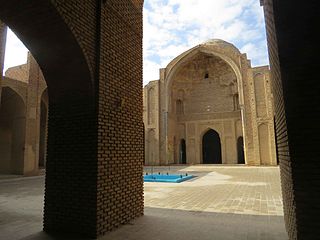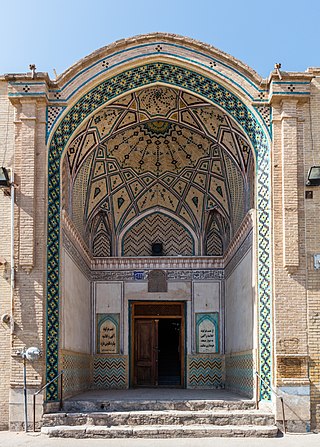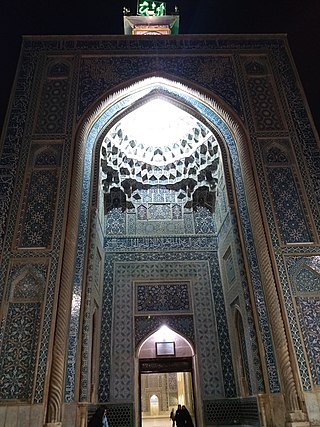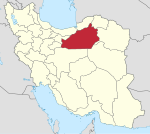
Iranian architecture or Persian architecture is the architecture of Iran and parts of the rest of West Asia, the Caucasus and Central Asia. Its history dates back to at least 5,000 BC with characteristic examples distributed over a vast area from Turkey and Iraq to Uzbekistan and Tajikistan, and from the Caucasus to Zanzibar. Persian buildings vary greatly in scale and function, from vernacular architecture to monumental complexes. In addition to historic gates, palaces, and mosques, the rapid growth of cities such as the capital Tehran has brought about a wave of demolition and new construction.

Semnan is a city in the Central District of Semnan County, Semnan province, Iran, serving as capital of the province, the county and the district. The city is on the alluvial fan of the Golrudbar creek in the north-central part of the country, 216 km east of Tehran and 640 km west of Mashhad. With a population of 185,129 people in 2016, Semnan is the most populous city in the province and the hub of the Semnani language, a sub-branch of the Iranian languages spoken to the north. It is home to the Semnani ethnic group.

Varamin is a city in the Central District of Varamin County, Tehran province, Iran, serving as capital of both the county and the district.

Damghan is a city in the Central District of Damghan County, Semnan province, Iran, serving as capital of both the county and the district.

Saveh is a city in the Central District of Saveh County, Markazi province, Iran, serving as capital of both the county and the district. It is about 120 km (70 mi) southwest of Tehran.

The Jāmeh Mosque of Borujerd is a congregational mosque (Jāmeh) in Borujerd, in the province of Loristan, western Iran. The mosque is the oldest mosque in the Zagros area and western Iran. It ranks as No. 228 in the Inventory of National Artefacts of Iran.

The Jāmeh Mosque of Isfahān or Jāme' Mosque of Isfahān, also known as the Atiq Mosque and the Friday Mosque of Isfahān, is a historic congregational mosque (Jāmeh) of Isfahan, Iran. The mosque is the result of continual construction, reconstruction, additions and renovations on the site from around 771 to the end of the 20th century. The Grand Bazaar of Isfahan can be found towards the southwest wing of the mosque. It has been a UNESCO World Heritage Site since 2012. It is one of the largest and most important monuments of Islamic architecture in Iran.

The Jāmeh Mosque of Yazd is the grand, congregational mosque (Jāmeh) of Yazd city, within the Yazd Province of Iran. The mosque is depicted on the obverse of the Iranian 200 rials banknote.

The Amr ibn al-As Mosque is a mosque in Cairo, Egypt. Named after the Arab Muslim commander Amr ibn al-As, the mosque was originally built in 641–642 CE as the center of the newly founded capital of Egypt, Fustat. The original structure was the first mosque ever built in Egypt and one of the first in Africa. For 600 years, the mosque was also an important center of Islamic learning until al-Muizz's Al-Azhar Mosque in Islamic Cairo replaced it. Through the twentieth century, it was the fourth largest mosque in the Islamic world.

The Jameh Mosque of Saveh is a Seljuk-era mosque, located in Saveh, Iran. This monument was built in the 12th century, coinciding with the establishment of the city itself.

The Tarikhaneh Mosque, is a historic monument located on the southern limit of the present day city of Damghan, Iran.

The Jameh mosque of Kashan is the oldest historical structure in Kashan, Iran. Its only brick minaret is located in its southeastern corner. On the bottom part of the minaret, there is a kufic inscription made by embossed brick. On the inscription, it is mentioned the construction date of the minaret, which is 1074 AD. The minaret is the third oldest minaret in Iran, which has an inscription.

The Jameh Mosque of Golpayegan is one of the important mosques of the Seljukid era and one of the large mosques in Iran. In view of its construction date, it may be said that its Iranian Islamic architecture was a model for building other large mosques specially the mosques, which were in the territory of seljukid dynasty. This mosque is located in the Masjed Jameh street in Golpayegan.

Jameh Mosque of Kerman is a mosque located in Kerman, Iran. The mosque was built at the time of Mubariz al-Din Muhammad, Muzaffarids, in the 14th century. The western side of the building features a high portal which has been decorated with decorative tile-works and a watch tower.

Jameh Mosque of Sabzevar is one of the oldest mosques in Sabzevar, built during the Sarbadars period.

Jameh Mosque of Sari is related to the Qajar dynasty and is located in Sari, the district of Chinarban. The Jameh Mosque of Sari is located in Nargesiye daily market in Chenarbon district in Sari, the capital city of Mazandaran Province, in North of Iran. It dates back to pre-Islam era and used to be a fire-temple of Zoroastrians of Iran in the North, next to the Caspian Sea. After the acceptance of Islam by the people in the region, a mosque, known as Jameh Mosque, was constructed on the site of the temple. It is the first mosque built in the North of Iran.

Jameh Mosque of Bandar Abbas or Jameh Mosque of Delgosha is one of the oldest mosques in Bandar Abbas, the capital of Hormozgan province in southern Iran.

Jameh Mosque of Gorgan is one of the monuments of Gorgan. This mosque is located next to the Bazaar Nalbandan. The mosque is built in the Seljuq dynasty and has spherical minaret on which are the Kufic line.

Jameh Mosque of Shushtar related to the Caliphate of Hasan al-Askari, Abbasid Caliphate And was built in Shushtar.


































